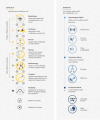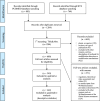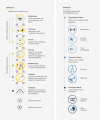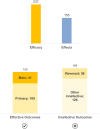What happens when we modify mosquitoes for disease prevention? A systematic review
- PMID: 32041484
- PMCID: PMC7034073
- DOI: 10.1080/22221751.2020.1722035
What happens when we modify mosquitoes for disease prevention? A systematic review
Abstract
The release of modified mosquitoes to suppress/replace vectors constitutes a promising tool for vector control and disease prevention. Evidence regarding these innovative modification techniques is scarce and disperse. This work conducted a systematic review, gathering and analysing research articles from PubMed and Biblioteca Virtual em Saúde databases whose results report efficacy and non-target effects of using modified insects for disease prevention, until 2016. More than 1500 publications were screened and 349 were analysed. Only 12/3.4% articles reported field-based evidence and 41/11.7% covered modification strategies' post-release efficacy. Variability in the effective results (90/25.7%) questioned its reproducibility in different settings. We also found publications reporting reversal outcomes 38/10.9%, (e.g. post-release increase of vector population). Ecological effects were also reported, such as horizontal transfer events (54/15.5%), and worsening pathogenesis induced by natural wolbachia (10/2.9%). Present work revealed promising outcomes of modifying strategies. However, it also revealed a need for field-based evidence mainly regarding epidemiologic and long-term impact. It pointed out some eventual irreversible and important effects that must not be ignored when considering open-field releases, and that may constitute constraints to generate the missing field evidence. Present work constitutes a baseline of knowledge, offering also a methodological approach that may facilitate future updates.
Keywords: Vector-borne diseases; Wolbachia; genetically modified mosquitoes; transgenesis.
Conflict of interest statement
No potential conflict of interest was reported by the author(s).
Figures







Similar articles
-
Designing effective Wolbachia release programs for mosquito and arbovirus control.Acta Trop. 2021 Oct;222:106045. doi: 10.1016/j.actatropica.2021.106045. Epub 2021 Jul 15. Acta Trop. 2021. PMID: 34273308 Review.
-
Modeling and dynamics of Wolbachia-infected male releases and mating competition on mosquito control.J Math Biol. 2020 Jul;81(1):243-276. doi: 10.1007/s00285-020-01509-7. Epub 2020 May 26. J Math Biol. 2020. PMID: 32458175
-
Use of age-stage structural models to seek optimal Wolbachia-infected male mosquito releases for mosquito-borne disease control.J Theor Biol. 2019 Jul 7;472:95-109. doi: 10.1016/j.jtbi.2019.04.010. Epub 2019 Apr 13. J Theor Biol. 2019. PMID: 30991073
-
Updates on traditional methods for combating malaria and emerging Wolbachia-based interventions.Front Cell Infect Microbiol. 2024 Apr 23;14:1330475. doi: 10.3389/fcimb.2024.1330475. eCollection 2024. Front Cell Infect Microbiol. 2024. PMID: 38716193 Free PMC article. Review.
-
Combined sterile insect technique and incompatible insect technique: sex separation and quality of sterile Aedes aegypti male mosquitoes released in a pilot population suppression trial in Thailand.Parasit Vectors. 2018 Dec 24;11(Suppl 2):657. doi: 10.1186/s13071-018-3214-9. Parasit Vectors. 2018. PMID: 30583749 Free PMC article.
Cited by
-
Wolbachia: endosymbiont of onchocercid nematodes and their vectors.Parasit Vectors. 2021 May 7;14(1):245. doi: 10.1186/s13071-021-04742-1. Parasit Vectors. 2021. PMID: 33962669 Free PMC article. Review.
References
-
- Medlock JM, Hansford KM, Schaffner F, et al. . A review of the invasive mosquitoes in Europe: ecology, public health risks, and control options. Vector Borne Zoonotic Dis. 2012;12(6):435–447. Available from: http://online.liebertpub.com/doi/abs/10.1089/vbz.2011.0814. - DOI - PMC - PubMed
-
- Nazareth T, Seixas G, Sousa CA.. Climate change and mosquito-borne diseases. In: Leal Filho W, Brandli L, Kuznetsova O, Finisterra do Paço AM, editors. Integrative approaches to sustainable development at university level. Cham: Springer; 2015. p. 187–199. Available from: http://link.springer.com/10.1007/978-3-319-10690-8 - DOI
Publication types
MeSH terms
LinkOut - more resources
Full Text Sources
Other Literature Sources
